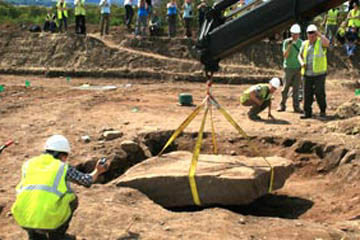Forteviot Discovery Excites Serfs
Archaeological Diggings is, of course, dedicated to Middle Eastern archaeology, but from time to time something is discovered elsewhere that is so interesting or so important that it simply cries out to be mentioned. Something of the sort has happened at Forteviot, a small village in Perthshire.
The site was already famous for its association with Kenneth mac Alpine, a Pictish king who died in AD 858 in his palace at Forteviot. A number of Pictish stones, including two crosses and a unique arch carved from a single block of stone, are known from the vicinity and there is also a Pictish graveyard. However a few years ago aerial photography during a drought revealed a large number of remains that date back to the Neolithic - a huge henge nearly 800' in diameter, and a number of burials.
A special project rejoicing in the acronym SERF - Strathearn Environs and Royal Forteviot - was set up to investigate the area and last year (2008) they found an exceptional tomb. Most of the burials were covered with stone slabs the same size as the grave, but this one was covered with a block of stone that weighed four tons! Neolithic man may have lugged such stones around the countryside as a matter of course, but modern man had to wait while he negotiated a concessionary hire price on a large crane, with the result that the tomb was not finally uncovered until last week (August, 2009).

|
| Two members of the SERF project team watch as a crane lifts a four-ton stone block that covered a well-preserved 4,000 year old tomb. |
The result was well worth the wait. The size and weight of the stone had been enough to completely seal the burial, with the result that as well as a few metal objects such as a bronze dagger decorated with a gold band, the archaeologists were astounded to find organic material such as the leather sheath for the dagger! Near the body lay a leather bag and some wooden objects that could not be identified immediately. There were also other fragments that may represent the remains of flowers and wreaths buried with the individual.
Most exciting of all was the stone "sarcophagus" consisting of a bed of quartz pebbles covered with sand and surrounded by stone slabs on edge. Similar "sarcophagii" have been found before but what was different here was that inside the sarcophagus was a coffin made of birch bark!
Unfortunately the owner of all this magnificence had not survived as well as his belongings. According to reports, all that remained was grave wax or adipocere. It seems odd to me that this should survive while the bones disappear, but I can only report what the archaeologists report.
Dr Kenneth Brophy, co-director of the SERF project, told the press: “We had a hunch that it would be a burial chamber but we didn’t expect it would be undamaged. It was really beyond our expectations. The high quality of preservation is virtually unique in Britain and is of exceptional importance for understanding the important centuries when metals were first introduced into Scotland.”
Meanwhile, as the archaeologists milled around taking photographs and speculating wildly on whether the deceased was a chief or wealthy merchant or other high-status individual, the sun carried on with its appointed course and began to set behind the hills which flank Forteviot. As its near-horizontal rays lit up the scene someone with sharp eyes spotted marks pecked into the underside of the four ton slab. They appeared to depict a bronze axe, which leaves the archaeologists speculating about the cultic significance of bronze axes and leaves me marvelling that someone was able to get at the underside of that four-ton block of stone and peck decorations into it - and clearly only a short time before it was put in place on the grave. Had it been pecked there earlier, it would have been scraped off was the stone was dragged over the ground!
That caused a closer examination of all the stones in the grave and further pecked decorations were identified on the stone slabs that make up the head-end of the "sarcophagus".
A delighted Professor Stephen Driscoll, another co-director of the SERF project, says: "This excavation is part of a long-term project to study the link between the emerging kingdom of medieval Scotland and its ancient prehistoric remains. This burial provides the strongest evidence of the presence of ancestral graves which may have been regarded as mythological heros by the Picts who were also buried nearby in Forteviot."
Whether such speculations are borne out after the evidence has been analysed remains to be seen, but no one can dispute the statement by yet another SERF co-director, Dr Gordon Noble, who said, "Until the grave goods are fully analysed it will be difficult to say a great deal about the person buried here, but it is clear that this was a person of tremendous importance to the local community."
The discovery has aroused so much local interest that the SERF team are holding an open day on Sunday, August 16, 2009. I just wish I lived closer and could pay a visit.
adipocere Adipocere is a crumbly white wax that is produced by a chemical reaction of water and hydrogen mediated by bacterial enzymes, which break down body fat to fatty acids and soaps. The resultant product is resistant to further bacterial attack. Adipocere can start to form within a month of death, provided that insects are not able to get at the body. It is chiefly found on the fatty parts of the body such as cheeks, breasts, belly and buttocks. Return
© Kendall K. Down 2009





